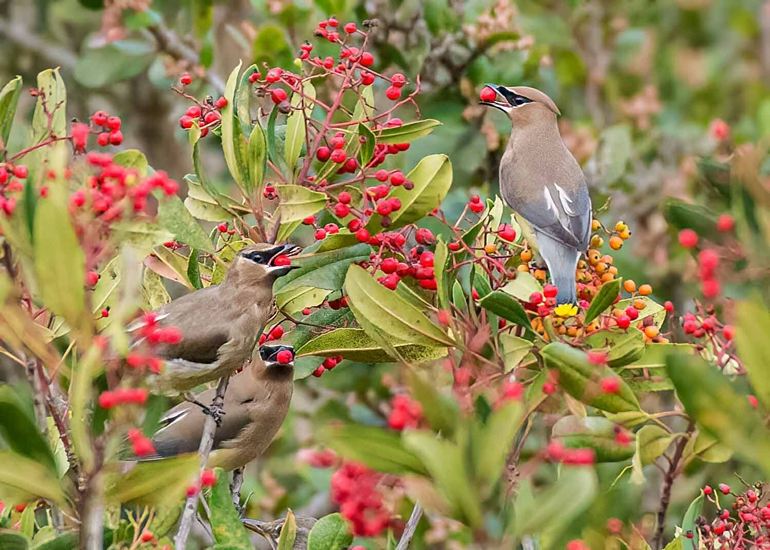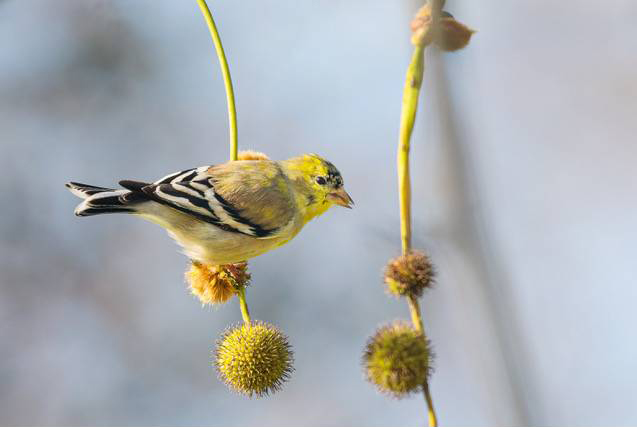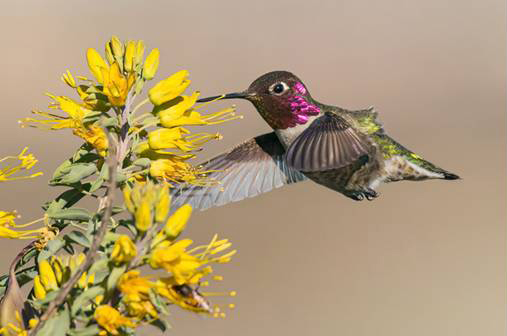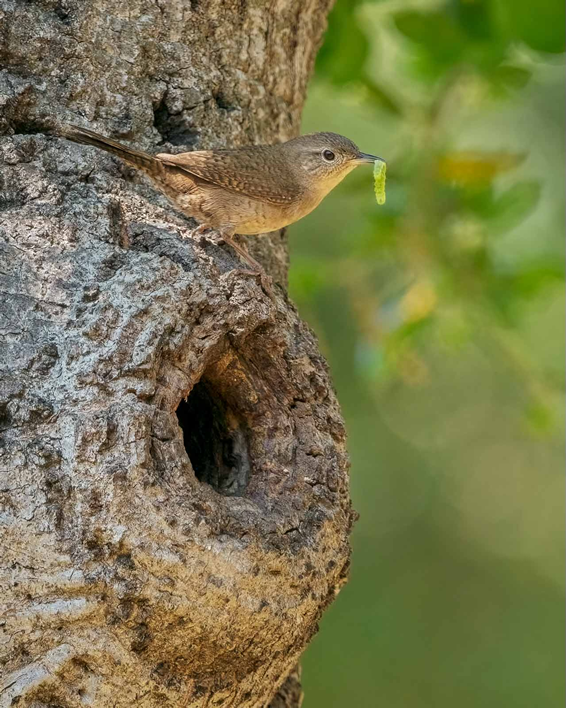Gardening for Birds

Toyon berries are a major source of food for Cedar Waxwings in winter. (Barbara A. Swanson)
By Joan Herskowitz
Creating a garden hospitable to birds is not only a personally gratifying connection with nature and opportunity to beautify the home environment, it is also important for sustaining resident and migratory bird populations. Due to habitat loss, native plant gardening is important for maintaining biodiversity. Doug Tallamy, ecologist and author, writes that it’s not enough to preserve native habitat in parks, we need to grow native plants in our gardens to establish wildlife corridors throughout neighborhoods. Native plants provide food for insects, the nutritious mainstay in most bird diets, as well as food for butterflies, sawflies and bees, insects responsible for most plant pollination. Native plant gardens are relatively low maintenance, using less water, fertilizer, and soil amendments, and eliminating the need for pesticides.
Planning a native garden involves consideration of site conditions; e.g., sun or shade, soil moisture retention ability, and site contour and steepness. A source of assistance in this regard is the website calscape.com that provides a list of plants that naturally grow in your area and are likely to do well in your garden. Don’t forget we have many microclimates in our county, so choose natives that are well adapted to the microclimate of the zone where they will be planted (coastal, inland valley, mountain, or desert). Birds are attracted to layered plantings with foliage from trees, shrubs, vines, perennials, and annuals that accommodate the range of bird activities for securing food, shelter, and safety from predators, and sites for perching and nesting.
Trees, even just one, such as an oak, willow, or sycamore, provide a range of benefits for birds. In addition to trees, or in smaller gardens, evergreen shrubs such as scrub oak (Quercus dumosa) and lemonadeberry (Rhus integrifolia) attract insects and birds, as well as serve as a dense protective network. The selection of plants that flower, fruit, and set seed at different times provides a succession of food sources throughout the year. Mass plantings are more likely to attract the attention of both insects and birds. Although birds obtain water from their food, they are attracted to a bird bath or shallow bowl of water for drinking and bathing.
To attract different types of birds, the garden will need a variety of food sources due to each bird species’ preference for seeds, fruits, berries, insects, or nectar. Although wrens, bluebirds, woodpeckers, and warblers feed primarily on insects, almost all birds feed on protein-rich insects, particularly insect larvae, when feeding chicks and fledglings.

American Goldfinches feed on seeds produced on a variety of native plants, including the seed clusters on this sycamore tree. (Barbara A. Swanson)
Sparrows, towhees, finches, and goldfinches are primarily seed-eating birds that are attracted to plants such as California sunflower (Encelia californica), sages (Salvia spathacea, S. aping, S. leucophylla, S. mellifera), California buckwheat (Eriogonum fasciculatum), and chaparral mallow (Malacothamnus fasciculatus).

Anna’s Hummingbirds are attracted to the colorful bladderpod flowers and feed on the plant nectar. (Barbara A. Swanson)
Hummingbirds and orioles feed on nectar-rich flowers with preference for tube-shaped red or other bright-colored flowers. Some of these plants with staggered blooming times include manzanitas (Arctostaphylos sp.), fuchsia-flowered gooseberry (Ribes specious), red bush monkeyflower (Diplacus aurantiacus var. puniceus), western columbine (Aquilegia formosa), Dudleya sp., foothill penstemon (Penstemon heterophyllus), and California fuchsia (Epilobium canum). The hardy evergreen bladderpod (Peritoma arborea) produces flowers nearly year-round that are highly attractive to hummingbirds and butterflies.
Robins, cedar waxwings, bluebirds, thrushes, and thrashers mostly feed on insects during the breeding season, but berries are an important food source in winter. Some native berry plants include: blue elderberry (Sambucus mexicana), laurel sumac (Malosma laurina), toyon (Heteromeles arbutifolia), holly leaf cherry (Prunus ilicifolia), California coffeeberry (Fragula Californica), coast barberry (Berberis piñata), and holly leaf redberry (Rhamnus ilicifolia).
 Vines such as virgin’s bower (Clematis asiantha), wild grape (Vitis girdiana), and honeysuckle (Lonicera hispidula) not only provide protection and nesting sites for small birds, but also produce nectar-filled flowers and fruits for many others attracted to your garden.
Vines such as virgin’s bower (Clematis asiantha), wild grape (Vitis girdiana), and honeysuckle (Lonicera hispidula) not only provide protection and nesting sites for small birds, but also produce nectar-filled flowers and fruits for many others attracted to your garden.

